Sorry, only photocopy Black & White pictures!
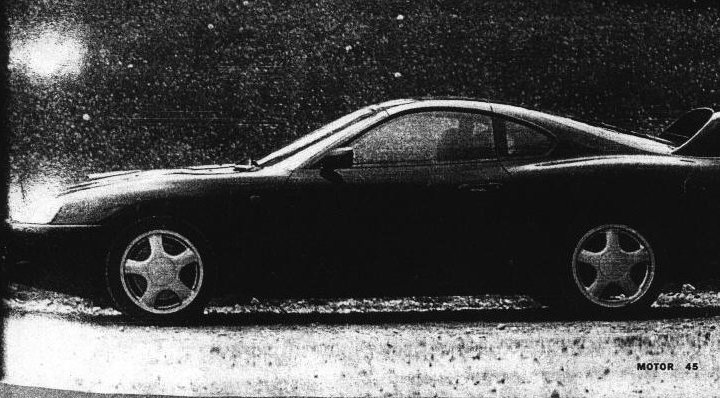
| Motor - Aug 1994 |
|---|
| BMW 850 CSi v Toyota Supra Mkiv |
BMW's top shelf 850 CSi and Toyota's wild and wonderful Supra nearly made it to the Australian market, and if they had the BMW would easily have doubled the Toyota's pricetag. The're close in power and performance after pushing them hard in the autobahn fast lane and over some of southern Germany's most challanging backroads, the conclusion must be these really are the one's that got away. Finally, we're trundling through the out-skirts of Munich, heading south-east out of the city. We've just picked up "our" 850 CSi from an impossibly hi-tech BMW dealership (BMW Niederlassung Munchen), one of the biggest in Germany, having spent the best part of 15 minutes, working our way out of the labryrnthine underground carpark. But to get to that point we had to establish our bona fides with the uniformed, officious, and rather rotund overseer of the Munich press fleet. Luckily our European Editor Greg Kable has acquired an impressive grasp of the Deutsch lingo in the 12 months since he left MOTOR's Sydney office and moved to Stuttgart. With photographer Karl-Heinz filling in the gaps, we eventually, did enough to convince the keeper of the keys to hand over a set for the big 850. 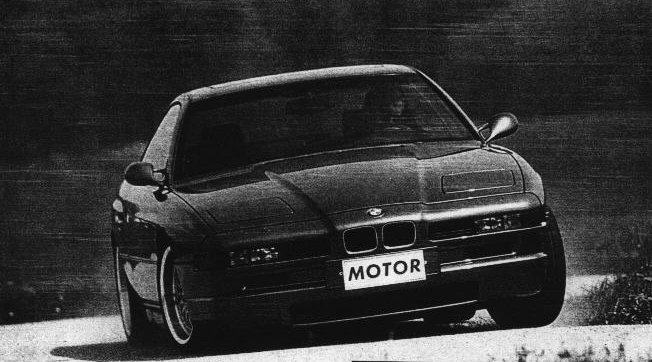
The huge carpark was filled with a mouthwatering array of BMWs including some new Sevens, the odd M3 and M5, as well as a sprikling of 850 CSis. The M3 might hold the mantle as the quickest of the current crop of BMWs, but there's something about the big-bopper 850 CSi that commands particular respect. The lower stance, the deeper, more substantial front spoiler with bigger brake cooling ducts, and the bigger rims shod with fat Michelin MXX3 rubber, go together to toughen the coupe's appearance considerably. We spotted the nose of our Barbados Green car poking out from behind a pillar. 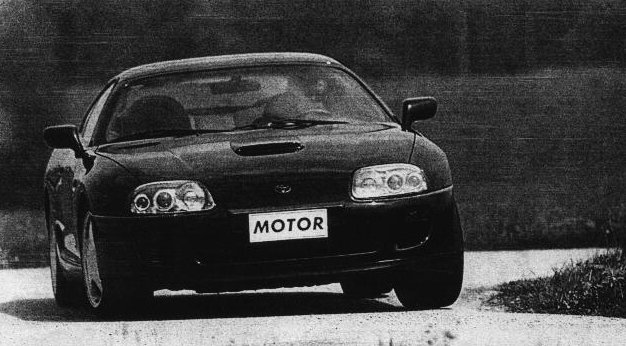
Opening the door is all it took to realise this car was loaded with optional equipment on top of the usual swag of electrically powered goodies fitted to the 8-Series. The owners papers listed passenger side airbag, tinted windows, electric tilt sunroof, electric rear window blind, sports seats, heated front seats, headlight washers, premium quality speakers and a sports steering wheel. The last two on the list, velour carpet and wood trim kit, were the biggest worry however. The combination of the lurid aqua carpet, with matching leather inserts in the sports seats, and the light coloured wood veneer trim around the dash and console, was never going to be to everyone's taste, least of all ours, as we loaded the car up, set the electrically adjustable steering and seats (complete with an electric adjuster for the under knee support pad), and battled our way out of the building. Next stop was just down the Frankfurter-Ring at Helfer Toyota, where the radical, shark-like profile of a black Supra Turbo dominated the forecourt. Black is such an appropriate colour for the Supra, enhancing its menacing, lurking presence on the road. The height of the rear wing has to be seen to be believed, and the bulging guards accentuate the car's low, wide look. Getting the Supra into the test had proved something of a trial with Toyota's German office in Cologne unused to requests from Australia for test cars in Munich. Finally Herr Grosse (literally the Mr Big of Toyota in Germany) gave us the green light thanks to some persistent lobbying from Greg Kable and Toyota Australia. 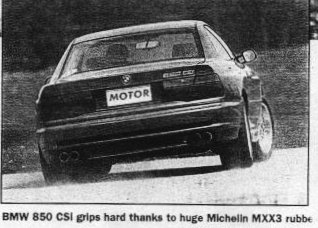
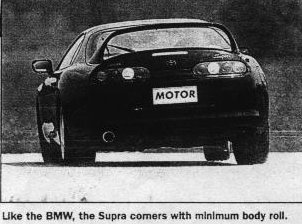
Relatively speaking the Supra's interior is a world away from the BMW's high quality, high luxury feel. Like the 850 CSi, "our" Supra came fitted with a swag of electric power equipment as well as a driver and passenger airbag, heated seats, grippy leather trimmed sports seats and sports wheel, even a lift-out targa roof panel. But the Toyota can't match the sense of occasion a step into the BMWs cabin evokes. The grade of plastic used on the interior trim, the fit and finish, even the leather on the chairs and steering wheel is not up to the BMW's mark. However the Munich dealership's owner, Herre Helfer, couldn't have been more positive. He gave us a pre-drive briefing and an inside tip. According to him there's a little plug somewhere in the engine bay, the disconnection of which cuts out the electronic 250 speed limiter. He went on to say that thanks to that little tweak, on a straight, three lane autobahn: he's seen revs on the Supra's odometer in fifth that equate to 305 km/h. 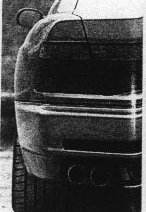
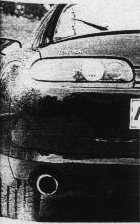
There was no doubting we had a pair of fast lane heavy-weights on our hands. It was a beautful mid-spring day, around 20 degrees, the autobahn beckoned, and my right foot was getting itchy. Our drive program took in hundreds of kays around the Bavarian alps, including a solid speed on the autobahn and lots of swift running over some high quality backroads. But for now the 850 CSi's 5.6-litre V12 was barely ticking over in the Munich traffic. In top (sixth) gear 80 km/h equates to just 1500 rpm, but even at that planting the right foot resulted in a surge of acceleration. Put it this way, it was immediately apparent that this engine had a useful spread of torque. The truly exotic Supra turned heads wherever it went, and when we stopped at some traffic lights two people in a red, current model BMW began to peer over, leaning right out of their seats, trying to read what tyres were fitted to it. There's no doubt the Supra looked wild with "that" wing and a row of four tiny tail lights perched at the end of the car's heavily tapered, massively bulbous tail. A chance to stretch the BMWs legs ... and the first thing that strikes you is the engine noise. BMW has made the V12 as throaty and growly as its eights, and the sound just gets better as the revs rise. THE AUTOBAHNWe swung on to the autobahn, and climbed up to a leisurely 140 km/h. Although the BMW boasts 12 cylinders in a vee, compared with the Toyota's six in-line, power outputs aren't split by the vast margin you might expect. Thanks to twin (sequential) turbochargers the Toyota pumps out a solid 243 kW, just 37 kW shy of the big BMWs monstrous 280 kW and 550 Nm. In fact the Supra's lighter kerb weight makes it quicker in a straight line from rest. But the 850 CSi's massive 550 NM of torque (110 NM more than the Supra) means that its in-gear acceleration is in another league. BMW Motorsport has had its wicked way with the 850's V12 and increased its capacity from 4988 cm to 5576 cm , at the same time upping the compression ratio from 8.8:1 to 9.8:1. The engine management has been suitably reprogrammed, and the inlet manifold and exhaust system have been modified to improve flow. The result is a thumping 280 kW to go with the aforementioned 550 Nm. A change from top to fifth accompanied by a squeeze of the throttle is all it took to gradually reel the Supra in. Back into top and the speed had risen to 200 km/h at 4000 revs just over 4400 rpm in top - sixth - in the Supra). 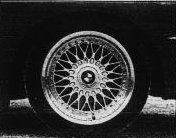
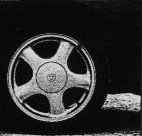
With almost 9000 km on the clock this 850 CSi was fully run in, and more than willing to push on from there. Barrelling through a long, sweeping bend at 220 km/h the road straightened, and as if on cue, broadened into three lanes. Time to go for it, and even at that speed flooring the throttle resulted in a solid shove in the back. At top speed, indicated at just under 260 km/h, the 850 CSi feels composed and reassuringly stable. The engine produces a deep thrum that competes with the tyre roar and wind noise. The pedal stayed buried to the firewall for several kilometres, each one flashing by as the trip meter started to spin like the dials on an old petrol bowser. Upcoming bends meant an ease back to 220 km/h, but the CSi continued to impress, with recirculating ball steering that always feeds back the right message from the front wheels, thanks largely to quicker acting Servotronic power assistance. The car has been lowered and the suspension stiffened, and through 200 km/h-plus sweepers feels calm and controlled, with just the right amount of compliance. The multi-link rear suspension has been upgraded on the CSi with active rear steering, computer controlled hydraulic rams acting on the upper links to improve the car's turn-in and stability in high speed transitions. After a solid stint behind the BMWs wheel, revelling in its massive grunt and refined chassis, it's time to pull into a service station and swap into the black beastie. A push on the centre pedal activates some of the biggest stoppers in the business (especially the huge 345 mm discs at the front), and just under two tonnes of 850 coupe is calmly reined in as we join the slower lanes and rumble on to the exit road. During the driver change we noticed, as sharp-eyed readers will that a small vent on the top of the bonnet, to help keep under bonnet temperatures in check, wasn't fitted to the car Japanese correspondent Peter Lyon pitted against the Nissan GT-R V-Spec for MOTOR late last year. That's because, in line with a Japanese Transport Ministry directive, power outputs are limited to 211 kW in the domestic market. Toyota wound back the Japanese Supra to 211 kW and 420 Nm via a different ECU calibration effecting the turbo wastegate and fuel injection. We also noticed the four big, fat pipes (two per side) pokng out from the CSi's rear, hinting at a serious Vee engine, while the Supra's enormous, single tailpipe is largely a product of weight saving, Toyota discovering that a dual exhaust system was no more efficient than a single. 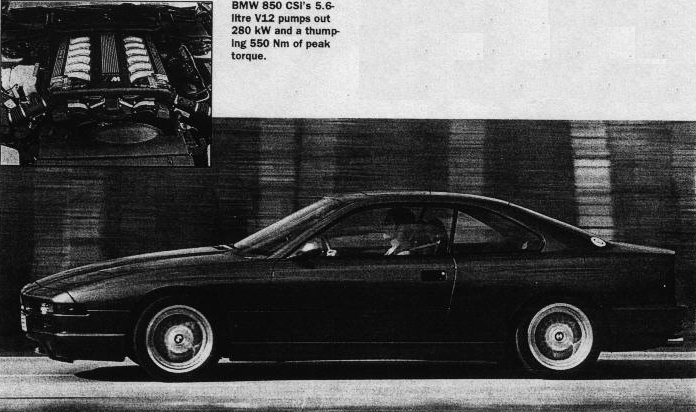
Now it was time to strap into the Supra and experience top-end, two-door performance, Japanese-style. With almost 20,000 km under its belt our Supra was well used to the fast lane, and we made a beeline for it. The Supra shares its 3.0-litre, dohc, 24 valve in-line six cylinder engine with the Lexus SC300 and GS300. But the twin sequential turbos effect a radical transformation. You can feel the boost building from as little as 1500 revs, and at 2500 the first, smaller turbo has reached full pressure. A distant swirl and whine heralds the arrival of the second, larger unit, and by 4000 rpm full boost is on board and the Supra is pulling like a train. The six-speed Getrag gearbox is slick but positive, and after some swift cog swapping the speedo needle has spun past 200 km/h. 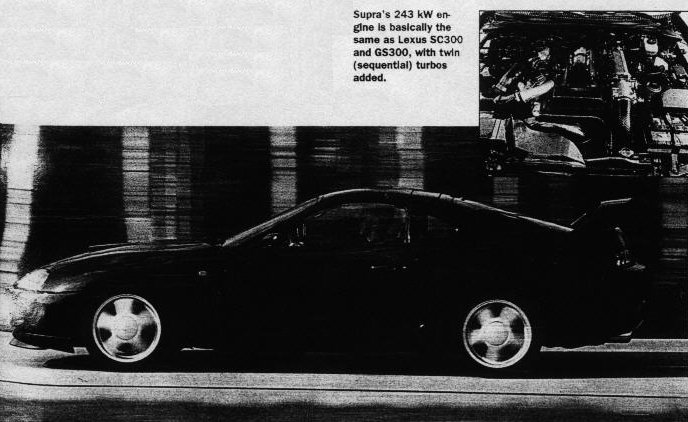
At speed it became immediately apparent that the Supra lacked ,the refinement and stability of the big BMW. A negative byproduct of the Supra's lighter weight is its nervousness over bumps that wouldn't even ruffle the 85O CSi's feathers. It was also obvious that the rack and pinion steering is lighter at all speeds, and lacked the BMW's superb feedback. The Supra sits on an extensively revised (140 mm longer) version of the Lexus SC300 platform. But the suspension, by unequal length arms at the front and semi-trailing arms at the rear, falls short in terms of balance. The Supra is obscenely fast however. According to Toyota the big ironing board on the back applies 45 kg of force at 145 km/h, so we must have been loading the rear end to the max as we scythed our wav towards 250 km/h. At that speed, in fifth particularly, the Supra felt as if it had plenty in hand, and Herre Helfer's claims of 300 km/h plus seemed totally believable. But unlike the super smooth BMW, the Supra was markedly upset by irregularities, even the small expansion strips on the autobahns thrumming back into the cabin and sending a strong message through the wheel. The engine note at high revs is a throaty wheeze, compared with the BMWs 12 cylinder bark. But the Supra commands a great deal of fast line cred. The appearance of its unusual shape in the rear view mirror of cars ahead often led to a quick move to the right and a bemused took as the Supra flashed past. 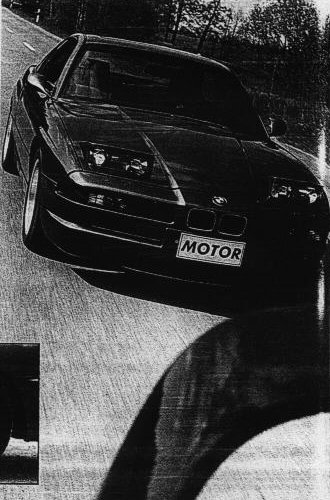
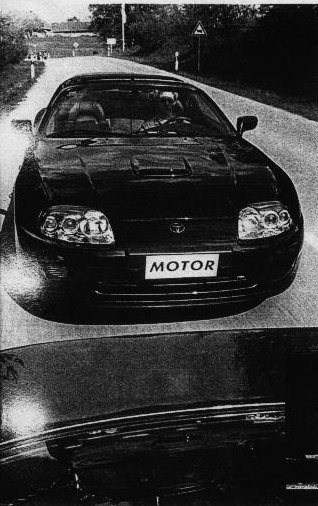
THE BACKROADSAn afternoon of autobahn blasting came to an end and we prepared for a good night's rest, and some serious gear changing the next day. We planned to literally head for the hills, and some of the most picturesque and challenging backroads in Germany. It turned out to be another beautiful spring day, the amazingly green valleys south of Munich at times giving way to solid peaks. On this beautifully smooth and nicely cambered blacktop, the BMWs compliant, well damped suspension and accurate steering again shone through. The heavily bolstered sports seats (spoiled slightly by an amazingly garish green insert in the leather trim) provide great support, the dash layout (unchanged from the standard car) is excellent, the engine growls with enormous mid-range punch, and the gear change is magnificent. It's a combination that saw the 850 CSi swallow serpentine sections of road with an agility that belied its not in-considerable weight. Push relentlessly and the front Michelins will eventually cry enough, allowing the car to push gently into understeer. But depending on the corner, and your frame of mind, a hard shove on the throttle before the apex will bring the tail out into a smooth power oversteer slide (with traction control switched off). On the other hand the Supra's six-speeder is the equal of the BMWs, and the electronically controlled sport/comfort suspension control is a big plus. Like the BMW the Supra corners with minimum of body roll, and here the suspension is less prone to the sharp, jittery reactions seen in the 200-plus zone, on the autobahn the day before. 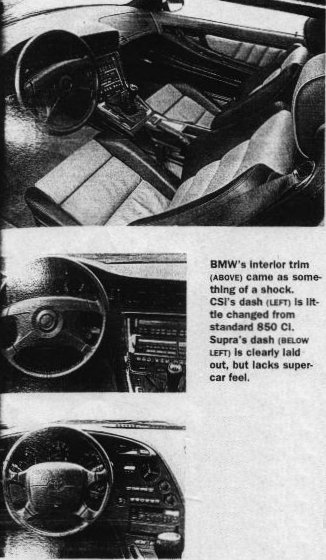
Set the car on a constant throttle and lock through quick corners, and undulations pass by with a surprising lack of fuss. The constantly fluctuating turbo whistle is the prelude to a long hard shove in the back, as the car rockets ahead with phenomenal force. Like the BMW the Toyota will understeer initially with a flood of power oversteer overcoming the grip of the rear Michelin Pilot SXs on command from the throttle. But the Supra's abilities are masked by its lighter and less communicative steering, disappointment through these sensational roads. The Toyota TRC (traction control system) has the same shutdown effect on the car in hard cornering as the BMWs ASC&T. Near the end of the day we're stopped near a lake on the way home, grabbing a few extra shots. A group of older people wander by and two men engage in deep conversation, obviously comparing. Finally they approach us to tell us how beautiful the 850 CSi is. It's as if the Supra doesn't exist. Their actions speak louder than a thousand words. The Germans have an abiding passion for cars. To them the Supra was designed to satisfy an appetite for speed, combined with a healthy load of gimmickry. The BMW is the result of a more conservative, long-term evolution. Get behind the wheel of the 850 CSi, and know that it's the car the 850 should have been all along. It's hard to say that at more than double the money the 850 CSi is twice as good as the Toyota Supra, especially when the Toyota is marginally faster in a straight line. On the Bang for your Bucks scale, the Supra wins hands down. But in terms of overall composure, refinement, dynamic ability and sheer quality, the BMW leaves Toyota's black shark behind, prowling for another victim. |
| Information | BMW 850 CSi | Toyota Supra |
|---|---|---|
| Engine | front, longitudinally mounted | front, longitudinally mounted |
| Cylinders | 60 deg V12 | six, in-line |
| Bore x Stroke(mm) | 80.0 x 86.0 | 86.0 x 86.0 |
| Capacity(cc) | 5576 | 2997 |
| Induction | electronic multi-point fuel injection | electronic multi-point fuel injection, twin turbos |
| Compression Ratio(:1) | 9.8 | 8.5 |
| Valve gear | cog belt driven, sohc/bank, two valves/cyl | cog belt driven, dohc, four valves/cyl |
| Power:KW @ rpm | 280 @ 5300 | 243 @ 5600 |
| Torque:Nm @ rpm | 550 @ 4000 | 440 @ 4800 |
| Maximum rpm | 6400 | 6800 |
| Specific power output | 50.1 kw/litre | 70.4 kw/litre |
| Gearbox | 6 Speed manual | 6 Speed manual |
| . | ........... km/h ...... max ....... At | ........... km/h ...... max ....... At |
| Gear | ratio . 1000 rpm . speed .. (rpm) | ratio . 1000 rpm . speed .. (rpm) |
| First | 4.250 ... 9.5 ........ 60 ...... 6400 | 3.830 ... 9.8 ........ 67 ...... 6800 |
| Second | 2.530 .. 15.9 ...... 102 ..... 6400 | 2.360 .. 16.0 ...... 109 ..... 6800 |
| Third | 1.680 .. 23.9 ...... 153 ..... 6400 | 1.690 .. 22.3 ...... 152 ..... 6800 |
| Fourth | 1.240 .. 32.4 ...... 207 ..... 6400 | 1.310 .. 28.8 ...... 196 ..... 6800 |
| Fifth | 1.000 .. 39.5 ...... 250 ..... 6350 | 1.000 .. 38.6 ...... 250 ..... 6500 |
| Sixth | 0.830 .. 48.4 ...... 250 ..... 5250 | 0.790 .. 48.0 ...... 250 ..... 5200 |
| Final Drive | 3.78 | 3.08 |
| Driving wheels | rear | rear |
| Suspension | Independent | Independent |
| Front | MacPherson strut,lower strut, coil springs, anti-roll bar | wishbones, coil springs, anti-roll bar |
| Rear | ind multi-link, coil springs, anti-roll bar | ind semi-trailing arms, coil springs, anti-roll bar |
| Wheels - front/rear | 8.0" x 17", 9.0" x 17" | 8.0" x 17", 9.5" x 17" |
| Tyres - make | Michelin MXX3 | Michelin Pilot SX |
| Tyres - front | 235/45 ZR17 | 235/45 ZR17 |
| Tyres - rear | 265/40 ZR17 | 255/40 ZR17 |
| Brakes | ABS | ABS |
| Front | vented 345mm discs | vented 322mm discs |
| Rear | 320mm discs | 325mm discs |
| Steering | power recirculating ball | power rack & pinion |
| Turns lock to lock | 2.8 | 3.0 |
| Turning circle(m) | 11.5 | 10.8 |
| Dimensions(mm) | two door coupe | three door coupe |
| Wheelbase(mm) | 2685 | 2550 |
| Track - front | 1554 | 1520 |
| Track - rear | 1564 | 1525 |
| Length | 4780 | 4514 |
| Width | 1855 | 1810 |
| Height | 1330 | 1275 |
| Ground clearance | n/a | 130 |
| Kerb weight(kg) | 1970 | 1549 |
| Weight to Power(kg/kw) | 7.0 | 6.4 |
| Fuel Tank(l) | 90 | 80 |
| Equipment | standard | standard |
| Adjustable steering | Yes | Yes |
| Airbag | Yes(driver and pass) | Yes(driver and pass) |
| Air-conditioning | Yes | Yes |
| Alloy wheels | Yes | Yes |
| Central locking | Yes | Yes |
| Cruise control | Yes | Yes |
| Leather trim | Yes | Yes |
| Power windows | Yes | Yes |
| Radio/cassette | Yes | Yes |
| Compact disc player | Yes | No |
| Sun roof | Yes | Yes |
| Trip computer | Yes | No |
| Performance(factory) | standing start | standing start |
| 0 - 100 km/h (62mph) | 5.9 | 5.4 |
| 0 - 120 km/h (75mph) | 7.9 | 7.7 |
| 0 - 1000m (1 km) | 25.5 | 25.0 |
| List Price | A$ 300,000 approx | A$ 130,000 approx |
Back to Home Page
Last modified on Monday, April 24, 2000